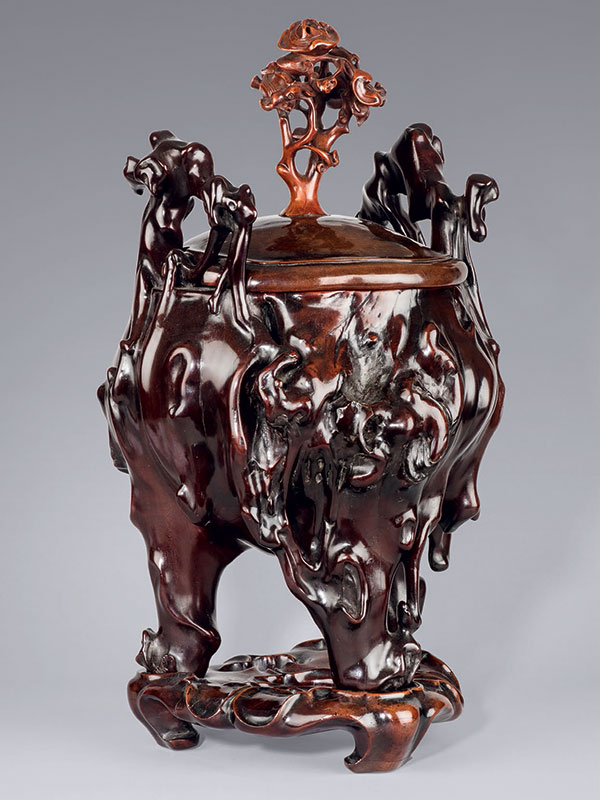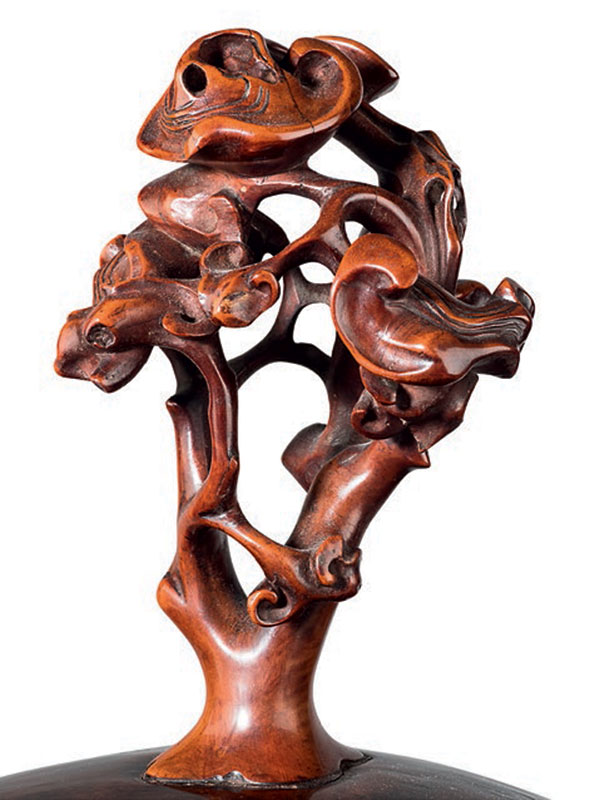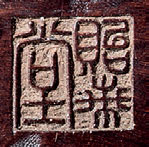Rootwood censer with wood cover
A large censer in the form of an archaic three-legged bronze vessel, ding, carved from a single large piece of rootwood. The round body is supported on three tall legs, with two loop handles extending upwards from the flat rim. Its well-polished smooth surface is carved with rounded, dramatic holes and apertures in addition to its natural fissures and gnarls. The wood is beautifully patinated and bears subtle reddish and yellowish tones in its brown colour. The slightly domed wood cover has a tall finial in the form of a branch of lingzi fungus, made from boxwood (huang yang mu). The stand is carved from a single piece of wood, with three cavities to accommodate the feet of the censer, and is itself supported on three short splayed feet. The interior of the cover is incised with a three-character seal mark in a square, reading Yi Lan Tang (‘Hall of bestowing on orchid’).
Furniture made of rootwood seems to have been already popular during the Tang (618 – 906) and Song (960 – 1279) dynasties. A painting attributed to Zhou Wenjin, a court painter who was active around 960, shows a scholar seated in an armchair fashioned from pieces of knotty branches or rootwood.[1] The associations of rootwood furniture with scholars and monks most likely grew out of Buddhist and Daoist concepts of humility, as well as their attempts to live harmoniously with the natural order of things.[2] In Siggstedt’s study of rootwood furniture, he notes that its use remained rather restricted until it became fashionable in the late Ming dynasty (1368 – 1644) within the circle of literati.[3] All pieces of rootwood furniture reflect a cultivated literati taste for peculiar effects rendered by natural forces rather than human artifice, and they consequently became very popular in the scholars’ studios and gardens to the south in the Yangtze delta and Guangdong regions during the Qing dynasty (1644 – 1911).[4] Three smaller rootwood censers of ding form, dated to the 18th century were formerly in the Qing Court collection: one with a wood cover fitted with a Yuan-dynasty (1279 – 1368) jade finial is now in the collection of the National Palace Museum, Taipei;5 two other censers are in the collection of the Palace Museum, Beijing.6
According to the mark Yi Lan Tang (‘Hall of bestowing on orchid’), this rootwood censer might have once been in the collection of a literati couple, Mr. Wu Si Lan (1908 – 1964) and Mrs. Qian Yi Lan (1917 – c. 1990), during the early China Republic period.
Provenance: private collection, England
1 The painting is in the collection of the Percival David Foundation. See Beurdeley, M., Chinese Furniture, Kodansha International, New York, 1979, p. 47
2 Jacobsen, R. D. etc., Classical Chinese Furniture in the Minneapolis Institute of Arts, Minneapolis Institute of Arts, Minneapolis, 1999, p. 102
3Siggstedt, M. ‘Chinese Root Furniture’, Bulletin, The Museum of Far Eastern Antiquities, Stockholm, 1991, no. 63, pp. 143-180
4 Jacobsen, R. D. etc. op. cit. p. 102
5 Chi, Jo-Hsin, Uncanny Ingenuity and Celestial Feats- The Carvings of Ming and Qing Dynasties: Bamboo, Wood, and Fruit Stones, National Palace Museum, Taipei, 2010, no. 31, pp. 130, 190
6 Yang, Bo-Da ed. Chinese Bamboo, Wood, Ivory, Rhinoceros Horn Illustration Catalogue, vol. II, Wood Carvings, Wen wu chu ban she, Beijing, nos. 103, 104, pp. 108-111
天然木根爐配蓋
清 十八 – 十九世紀 「貽蘭堂」篆書方款
爐高含蓋與底座:55 公分 爐高含耳:42.5 公分 寬:32 公分
天然木根爐,配蓋,含座。爐身雙耳三足,以整塊天然木根隨形製成,掏膛形成爐內空間,上配黃 楊木靈芝形鈕蓋,下配有三足底座。天然木,自唐代以降已用作傢俱,即是把奇形怪狀的樹根和長 滿樹瘤的木料做必要修整,雕塑或拼合為傢俱之用,具有極強的觀賞價值,亦為極具文人情調之文 房佳器。天然木爐可見清宮舊藏,如臺北國立故宮博物院藏癭木鼎式爐, 北京故宮博物院亦藏有 天然木鼎式爐,或與同為天然木製瓶與盒成為文房三套件,或與燭台和瓶成五件佛堂供器。 蓋底刻印「貽蘭堂」篆書方款,據考應為吳似蘭與錢倚蘭夫婦之堂名款。吳似蘭(1908-64)字 綠野,又字慶生。江蘇吳縣人,名畫家吳子深之弟,家為吳中望族,收藏宋元古畫甚富。吳似蘭工 畫兼善攝影,組織娑羅花館畫社。兄吳子深(1893-1972)於1927年在蘇州“滄浪亭”創設蘇州 美專校舍,自任校董及教授; 吳似蘭亦曾任蘇州美專教授兼校董。錢倚蘭(1917-90後),原名藕 姑,擅長書畫篆刻和昆曲,後被吳似蘭納為侍妾,取名倚蘭。吳歿後,嫁給喪偶的賀天健(1890-1977),更名晴瀾。中國西泠印社曾於2013年春拍出吳似蘭夫婦用印,其中包含一枚長方形篆書款 「貽蘭堂」印。同場亦拍出賀天健藏文房古玩,其中包含數件文房底部刻有「貽蘭堂」篆書款,併 有「老蘭生」之吳似蘭私款 ; 此類文房應為吳歿後,錢倚蘭再嫁賀天健時,一併納入賀氏收藏。 來源:英格蘭舊藏。據「貽蘭堂」印考,本器應曾為吳似蘭夫婦之藏品,後流傳至今。



